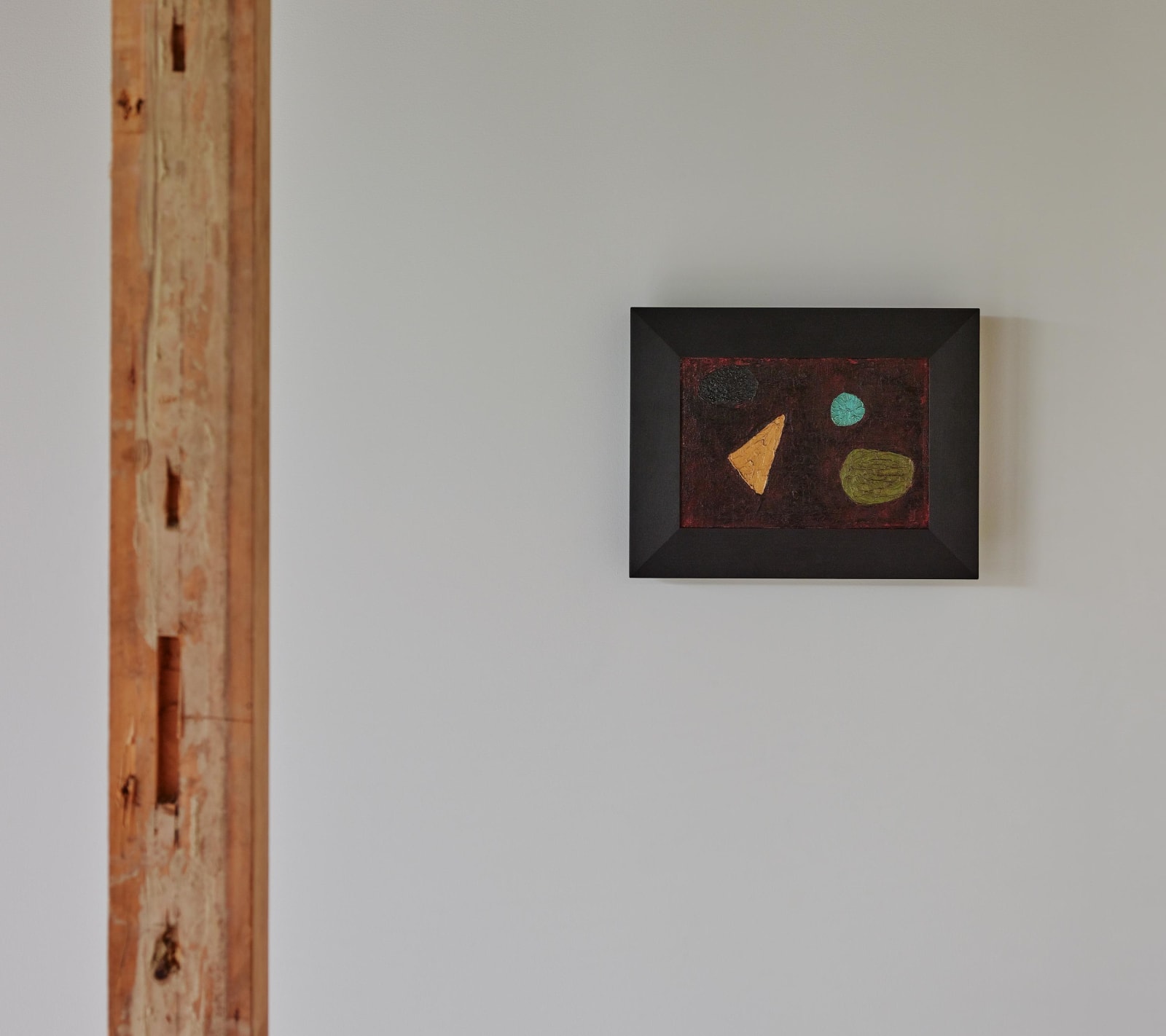Yamaguchi Takeo (1902–1983)
Sky
Oil on canvas, framed
Signed by the artist on the reverse
1948
With a certificate of Yamguchi Takeo Sakuhin Torokukai
16.5 x 23 cm
24 x 31 cm (overall)
Signed by the artist on the reverse
1948
With a certificate of Yamguchi Takeo Sakuhin Torokukai
16.5 x 23 cm
24 x 31 cm (overall)
Further images
In 1947, Yamaguchi won the First Members Encouragement Prize of the Nikakai organization. From around that time, Yamaguchi used a provisional room above the roof of the Hokuso Gallery in Tokyo’s Nihonbashi district to paint his works. In May the following year, he exhibited Sky A and Sky B at the Second Artist’s Associations Federation Exhibition. Certainly, looking at the cloudy Ginza skies in the era immediately after Japan’s defeat in the war might bring along all kinds of thoughts and ideas. During that era, Yamaguchi created works entitled Shape, Form, or Ellipse, then Bird, Flower, and Sky. The compositions are all based on circles, elliptical shapes or distorted rectangles. This suggests that the artist used titles that evoke representational art as well as titles that seem to stem from the realm of abstraction in parallel for works of the same kind. Perhaps the source of the present work were indeed the clouds in the sky of Ginza.
The four elements of the painting differ in shape and in color. Moreover, their inner textures also diverge from each other. The work is inscribed on the back with the words “Sky Showa 23, April Yamaguchi Takeo.”
From around 1947 to 1950, Yamaguchi’s works consist of circles and masses of indistinct shape that are arranged in seeming opposition on the painting’s surface. However, around 1951, he begins to rely primarily on circles and forms that resemble prolonged lines. This is the origin of Yamaguchi’s abstract works called Forms which he produced during the first half of the 1950s.
Looking Sky more closely, there are four shapes which, judging from the title, must be clouds in the sky. Or they could be birds flying. The texture of the brushstrokes is different for each of them, for instance the brushstrokes of the circle in light blue converge in the center. For the mass in dark green, they run in parallel. The black round shape is an accumulation of strokes, one next to the other. Furthermore, the triangular earthen-colored shape looks like a flattened tetrahedron, with strokes converging in an imaged peak near the sharpest of its angles. That considered, the “tetrahedron” may not represent a cloud but rather a bird. In this way, Yamaguchi based the different appearances and colors of his forms on actual forms of clouds or birds.
Yamaguchi Takeo (painter; 1902–1983)
Born in Seoul, Yamaguchi studied painting at Hongo Institute of Western Painting, Kawabata School of Painting and Tokyo School of Arts. In 1927, he co-founds the Jotokai group with Ogisu Takanori and Koiso Ryohei, then travels to Paris where he meets Ossip Zadkine as a lasting influence. In 1931, first participation in the Nikakai Exhibitions. Co-founder of Room Nine Art Association (1937), Japan Avantgarde Art Club (1947) and Japan Abstract Art Club (1953, with Yoshihara Jiro and others). In the 1950s and 1960s, Yamaguchi becomes one of the leading abstract painters in Japan, exhibiting widely in Japan and internationally (São Paulo Art Biennial, Guggenheim Museum New York, Expo ’70 in Osaka and many more).
The four elements of the painting differ in shape and in color. Moreover, their inner textures also diverge from each other. The work is inscribed on the back with the words “Sky Showa 23, April Yamaguchi Takeo.”
From around 1947 to 1950, Yamaguchi’s works consist of circles and masses of indistinct shape that are arranged in seeming opposition on the painting’s surface. However, around 1951, he begins to rely primarily on circles and forms that resemble prolonged lines. This is the origin of Yamaguchi’s abstract works called Forms which he produced during the first half of the 1950s.
Looking Sky more closely, there are four shapes which, judging from the title, must be clouds in the sky. Or they could be birds flying. The texture of the brushstrokes is different for each of them, for instance the brushstrokes of the circle in light blue converge in the center. For the mass in dark green, they run in parallel. The black round shape is an accumulation of strokes, one next to the other. Furthermore, the triangular earthen-colored shape looks like a flattened tetrahedron, with strokes converging in an imaged peak near the sharpest of its angles. That considered, the “tetrahedron” may not represent a cloud but rather a bird. In this way, Yamaguchi based the different appearances and colors of his forms on actual forms of clouds or birds.
Yamaguchi Takeo (painter; 1902–1983)
Born in Seoul, Yamaguchi studied painting at Hongo Institute of Western Painting, Kawabata School of Painting and Tokyo School of Arts. In 1927, he co-founds the Jotokai group with Ogisu Takanori and Koiso Ryohei, then travels to Paris where he meets Ossip Zadkine as a lasting influence. In 1931, first participation in the Nikakai Exhibitions. Co-founder of Room Nine Art Association (1937), Japan Avantgarde Art Club (1947) and Japan Abstract Art Club (1953, with Yoshihara Jiro and others). In the 1950s and 1960s, Yamaguchi becomes one of the leading abstract painters in Japan, exhibiting widely in Japan and internationally (São Paulo Art Biennial, Guggenheim Museum New York, Expo ’70 in Osaka and many more).







